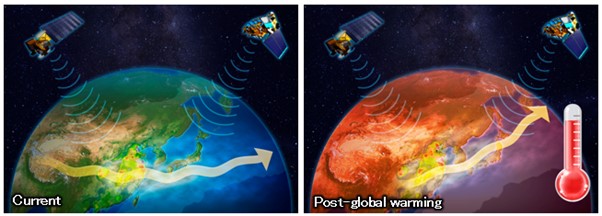Researchers propose a new metric using aerosols to understand changes in transboundary air pollution pathways due to climate changes
Researchers analyzed long-term aerosol satellite observation big data focusing on the Pacific Ocean downwind of China. Using a newly developed metric that considered aerosols as tracers, they detected altered atmospheric transport patterns associated with climate change. They observed that the distance of transboundary air pollution moving east from China had shortened. Thus, long-term satellite-based Earth observations are crucial for early climate change detection and accurate evaluation of this trend.

Image title: The image depicting transboundary air pollution pathways of aerosols, such as PM2.5
Image caption: By analyzing long-term satellite observation data and using a new method that treats aerosols as tracers, researchers found that these pathways from China are shifting slightly northward due to global warming
Image credit: Shinichiro Kinoshita
Image license: Original Content
Usage restrictions: Cannot be reused without permission
Climate change is one of the most significant environmental challenges of present times, leading to extreme weather events, including droughts, forest fires, and floods. The primary driver for climate change is the release of greenhouse gases into the atmosphere due to human activities, which trap heat and raise Earth’s temperature. Aerosols (such as particulate matter, PM2.5) not only affect public health but also influence the Earth’s climate by absorbing and scattering sunlight and altering cloud properties. Although future climate change predictions are being reported, it is possible that the impacts of climate change could be more severe than predicted. Therefore, it is necessary to detect climate change accurately and as early as possible.
Building on these insights, a research team from Japan, led by Professor Hitoshi Irie from the Center for Environmental Remote Sensing at Chiba University, utilized long-term observational data to study the effect of climate change on transboundary air pollution in the downwind area of China by using aerosols. They utilized a completely unique perspective on how aerosols impact climate and developed a new metric to detect climate change by considering aerosols as tracers.
“The significance of this study lies in the fact that most of its results are derived from observational data. In natural sciences focused on Earth studies, the ultimate goal is to piece together highly accurate data obtained from observations to quantitatively understand the processes occurring on Earth and to pursue immutable truths. Therefore, the more observational data we have, the better. With the continued Earth observations by Japan’s major Earth observation satellites (such as the GCOM series, GOSAT series, Himawari series, and ALOS series), we aim to complement these efforts with numerical simulations and data science methodologies to achieve a safe and secure global environment that mitigates the impacts of the climate crisis.” explains Prof. Irie.
The research team included Ms. Ying Cai from the Graduate School of Science and Engineering, Chiba University, Dr. Alessandro Damiani from the Center for Climate Change Adaptation, National Institute for Environmental Studies, Dr. Syuichi Itahashi and Professor Toshihiko Takemura from the Research Institute for Applied Mechanics, Kyushu University, and Dr. Pradeep Khatri from Faculty of Science and Engineering, Soka University. Their study was made available online on May 23, 2024, and published in Science of The Total Environment on August 20, 2024.
China is a major contributor to air pollution in East Asia. The downwind area of China analyzed in this study is a unique open ocean area with minimal human interference yet an important zone of transboundary air pollution pathways, making it an ideal location for studying meteorological variations due to climate change.
In their study, the researchers analyzed aerosol optical depth (AOD) datasets derived from satellites, reanalysis datasets, and numerical simulations focused on the Pacific Ocean in the downwind area of China, over 19 years from 2003 to 2021. AOD, a measure of the amount of sunlight blocked by aerosols, is a key factor is analyzing aerosols and their impact on climate change.
The researchers developed a new metric called RAOD which utilized the potential of aerosols as tracers to evaluate the impact of climate change on transboundary air pollution pathways. Using RAOD the researchers were able to quantify significant temporal variations in aerosol transport. They discovered that long-term changes in RAOD due to climate change were outweighed by larger year-to-year variations in the meteorological field. Moreover, seasonal trends showed that aerosols moved west to east during spring and winter, and northward in summer. They concluded that the probability of aerosols from China to be transported far eastward was low, highlighting a shift in transboundary pollution pathways due to global warming. In this study the authors successfully detected climate change using long-term satellite observational data, in contrast to most existing studies that tracked transboundary air pollution using model simulations.
“These results suggest that RAOD is a valuable metric for quantifying the long-term changes in transboundary air pollution pathways due to climate change. These results are particularly significant because most of them are derived from observational data,” says Prof. Irie, highlighting the importance of the study. Sharing the future implications of their study he concludes, “The effects of climate change could be more severe than currently predicted. This study will help verify climate change predictions from an unconventional perspective of ‘aerosol observation,’ enabling a more accurate understanding of climate change progression and implementation of rational countermeasures.”
In summary, this study demonstrates an innovative use of aerosols as climate change tracers, marking a significant step forward in the global effort to tackle the pressing issue of climate change.
About Professor Hitoshi Irie
Hitoshi Irie is currently a Professor at the Center for Environmental Remote Sensing (CEReS) at Chiba University. He obtained his M.S. and Ph.D. degrees from Nagoya University, Japan in 1999 and 2002, respectively. He has over 230 publications with over 6400 citations. At Chiba University, he also leads the Irie lab, which focuses on studying the effects of climate change. His research focuses on understanding the evolution of air pollution and climate change on a global scale.
Funding:
This research was supported by the Environment Research and Technology Development Fund (grant number JPMEERF20215005) of the Environmental Restoration and Conservation Agency of Japan, JSPS KAKENHI (grant numbers JP20H04320, JP21K12227, JP22H03727, and JP22H05004), the JAXA 3rd research announcement on the Earth Observations (grant number 19RT000351), and the Virtual Laboratory (VL) project by the Ministry of Education, Culture, Sports, Science and Technology (MEXT), Japan.
Reference:
Title of original paper: Detectability of the potential climate change effect on transboundary air pollution pathways in the downwind area of China
Authors: Ying Cai a, Hitoshi Irie a, Alessandro Damiani b, Syuichi Itahashi c, Toshihiko Takemura c, Pradeep Khatri d
Affiliations:
- Center for Environmental Remote Sensing (CEReS), Chiba University, Japan
- Center for Climate Change Adaptation, National Institute for Environmental Studies, Japan
- Research Institute for Applied Mechanics, Kyushu University, Japan
- Department of Science and Engineering for Sustainable Innovation, Faculty of Science and Engineering, Soka University, Japan
Journal: Science of the Total Environment
DOI: 10.1016/j.scitotenv.2024.173490
Contact: Hitoshi Irie
Center for Environmental Remote Sensing (CEReS), Chiba University
Email: hitoshi.irie@chiba-u.jp
Public Relations Office, Chiba University
Address: 1-33 Yayoi, Inage, Chiba 263-8522 JAPAN
Email: koho-press@chiba-u.jp
Tel: +81-43-290-2018
Recommend
-

Optimizing End-of-Life Happiness: The Future of Nursing through Technology
2024.05.31
-

Designing Mobility: A Gentle Force in Linking People and Society
2024.02.26
-

What causes nations and regions to perceive the COVID-19 crisis differently?〜Insights from the Humanities and Social Sciences Needed for Disaster Management Research
2022.12.12


